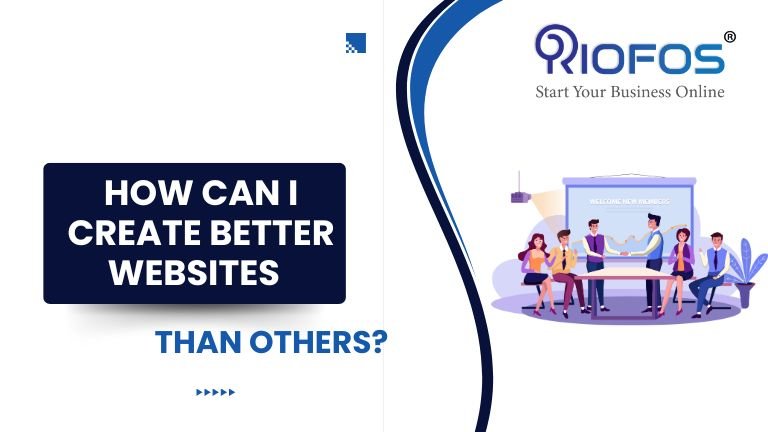In order to craft a website that outshines its competitors, it’s imperative to approach the task with a combination of strategic thinking, technical proficiency, and an acute understanding of user preferences. This guide will walk you through a comprehensive set of strategies and techniques, ranging from purposeful planning and user-centric design to compelling content creation and effective SEO implementation. By incorporating these elements, you’ll be well-equipped to build a website that not only meets but exceeds user expectations, setting it apart in a crowded digital landscape. Here are some key steps and strategies to help you create websites better than others.

Follow All The Steps and Know The Information About Create Websites
- Define Your Purpose and Audience: Before you start designing and developing your website, it’s crucial to define its purpose and target audience. Understand what problem your website aims to solve or what information it aims to provide. This clarity will guide all your subsequent decisions.
- Research and Plan: Conduct thorough research on your niche and competition. Identify successful websites in your field and analyze what makes them effective. Take note of design elements, content strategies, and user engagement techniques. Create a detailed plan that outlines your website’s structure, features, and content.
- Prioritize User Experience: User experience (UX) is paramount. Your website should be easy to navigate, with clear calls-to-action and intuitive menus. Ensure fast loading times, mobile responsiveness, and compatibility across different devices and browsers. A user-friendly website encourages longer visits and higher engagement.
- Unique and Compelling Content: Content is king. Create original, high-quality content that provides value to your audience. Use a mix of text, images, videos, and interactive elements to engage visitors. Consistency in tone, style, and messaging helps establish a strong brand identity.
- Optimize for Search Engines: Implement on-page and technical SEO techniques to improve your website’s visibility in search engine results. This includes keyword research, meta tags, header optimization, image alt attributes, and creating a sitemap. Regularly update and add fresh, relevant content.
- Integrate Engaging Visuals: Use eye-catching visuals that complement your content. High-quality images, graphics, and videos enhance the overall aesthetic appeal of your website. Ensure that visuals are optimized for web use to maintain fast loading times.
- Focus on Mobile-First Design: Given the increasing use of mobile devices, design your website with a mobile-first approach. This means ensuring that your site is fully functional and visually appealing on smaller screens. Responsive design techniques are essential for providing a seamless experience across all devices.
- Implement Effective Call-to-Actions (CTAs): Well-placed, clear, and compelling CTAs guide visitors toward desired actions, such as making a purchase, signing up for a newsletter, or requesting more information. Use actionable language and strategic placement to encourage conversions.
- Emphasize Branding: Consistent branding elements, such as logos, color schemes, and typography, help establish a strong visual identity. This fosters recognition and trust among your audience. Ensure that your branding elements align with your overall message and target audience.
- Prioritize Security and Privacy: Security is paramount in today’s digital landscape. Implement SSL encryption, regularly update software, and use strong passwords. Additionally, comply with data protection regulations, such as GDPR or CCPA, to safeguard user privacy.
- Integrate Social Media and Sharing Features: Connect your website with relevant social media platforms to increase visibility and engagement. Include social sharing buttons on your content to encourage users to share your content with their networks.
- Continuously Test and Optimize: Use analytics tools to track user behavior and gather insights. A/B testing can help refine elements like headlines, CTAs, and layout for better performance. Regularly update and improve your website based on the data collected.
- Stay Updated with Industry Trends: The digital landscape is ever-evolving. Stay informed about the latest web design and development trends, SEO techniques, and emerging technologies. Implementing cutting-edge practices can give your website a competitive edge.
- Provide Excellent Customer Support: Offer multiple channels for users to get in touch, such as live chat, email, or a contact form. Respond promptly to inquiries and address any issues or concerns promptly. A positive customer service experience can significantly enhance your website’s reputation.
- Build a Community: Foster a sense of community among your audience through forums, comment sections, or social media groups. Encourage discussions, feedback, and user-generated content. A thriving community can lead to increased loyalty and advocacy.
Conclusion
In conclusion, creating a standout website hinges on a holistic approach that encompasses purposeful planning, user-centric design, compelling content, and effective SEO strategies. By prioritizing user experience, security, and community building, you can establish a strong online presence that sets you apart from the competition. Remember, continuous optimization and staying abreast of industry trends are key to maintaining your website’s edge in a dynamic digital landscape. With these principles in mind, you’re poised to create websites that not only excel but also leave a lasting impression on your audience.
